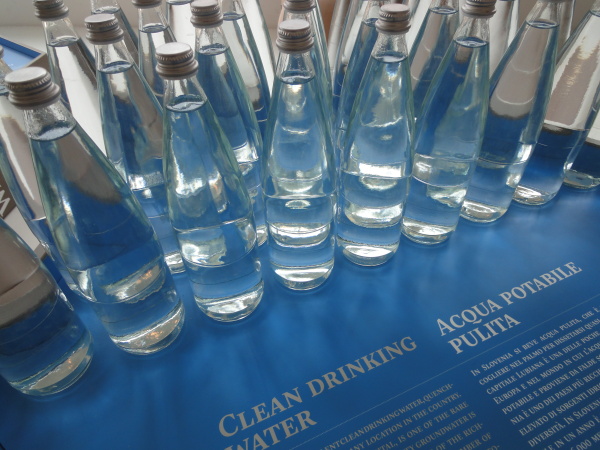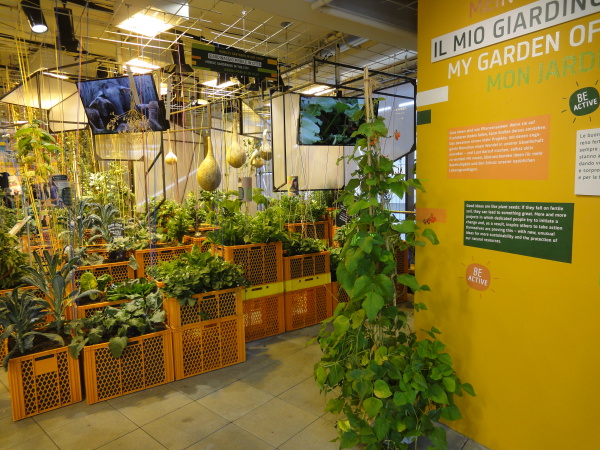Here are some other pavilions that caught my attention:
Switzerland
The Swiss pavilion was a bit hard to navigate for me, but in the end I found two main exhibitions there. One showed Swiss waterworks while the other one focused on urban agriculture in three Swiss cities.
Slovenia
Slovenia had a very pretty and clean interior. Information-wise, the highlights for me were a high-tech aquaponics system with the option to regulate mineral supply and importance of beekeeping. Bees, by the way, were very popular all over EXPO.
Russia
While most people came for the free booze, the pavilion was actually surprisingly good. While I went around saying that I wonder how come Russia is not embarrassed to show up at the EXPO after proudly destroying perfectly edible food just because it was imported from the West, the pavilion itself was pretty good.
The part which everybody skipped I actually liked – rating of fruits and vegetables most contaminated with pesticides. The order supposedly goes apples > peaches > nectarines > strawberries > grapes > celery > spinach > sweet peppers > cucumbers. It reminded me that I was planning to read up more on this topic, but I have been postponing it.
France
France was one of the most informative pavilions and I think it was really good, though it had a lot going on and since there was a movie streaming part by part across various sites, it also created pressure to move at a certain pace.
Some of the key inventions highlighted were genetic selection for improved crops, where a high tech robotic system is constantly scanning for interesting apparent traits that are then linked to the desired genes and it allows for faster breeding.
Another featured point was the possibility to re-create many materials from detergents to packaging to office supplies from renewable vegetal resources, focusing on utilizing as much of the plant as possible.
The hottest food industry innovation in France is startup Pret a Pousser / Ready to grow mushroom kit, which allows you to grow your own mushrooms in a cardboard box at home.
Packaging-free supermarkets were also mentioned. It makes sense, because I have found out that Czech Republic seems to be one of few countries where very few vegetables/fruits are pre-packed, or at least there is always a loose alternative. Yet in most other countries there are things which you have to buy packed in several layers of packaging.
Czech Republic
I am only showing this pavilion because, well, I am Czech and it appears to be very unique in one aspect – it is the only pavilion these days without a queue! Not a very good sign, eh? I have no idea who is responsible for the pavilion, but he deserves to be fired on the spot. While, with both eyes closed, some of the inventions such as recycled pet chairs, low-energy lab and real-time forest monitoring could somehow fit at least with the “energy” aspect of EXPO (though it would have needed much better story), a big part of the pavilion exhibited textiles. Textiles! When the topic of EXPO is "feeding the planet"! And yet there are several universities focusing on food science that surely must have made some relevant discoveries that could have been presented...
Italy
I think Italy’s problem was that everybody had too many expectations, so many of us ended up disappointed. I went there on a lucky day when I waited for less than an hour to enter – totally unthinkable any other day where queues were 4 h and longer.
At the beginning, Italy promises it will answer the task of EXPO by revisiting its strengths, which are supposed to be its (agricultural) craftsmanship, beauty, and innovation. But the whole exhibition – except for one room showcasing food entrepreneurs and one room showing some scientific advancements in agriculture and energy – just a showcase of Italy’s Wikipedia page. Great for selfies, not so great for looking for actual innovation.
My least favorite part is “World without Italy” showing Europe’s map missing the famous boot and screens showing people who seem to be high mumble random associations that come to their mind when they hear Italy. The whole thing just seemed very eco-centric and bloated.
Holland
The Dutch did, in my opinion the best job at actually answering the topic of EXPO.
Yet while their pavilion had a very cute design and was one of I think two pavilions that were basically 100% outdoors, the display was a little static and I am not sure if anybody but the geeks actually read all the very cool information:
- Robots can now harvest peppers instead of humans (I assume that the contribution is fewer errors, less possible contamination and higher efficiency?).
- Waste water can be turned into clean water, fertilizer and fishes (though the last one sounds like a little dodgy pre-19th century pseudo science… wonder if it is a mistake in the translation).
- Wageningen uni is growing food crops in soil from Mars, preparing thus for eventual colonization of the planet.
- The Dutch are also breeding salt-tolerant crops as well as engineering wheat to cope with global warming and drought.
- And making greenhouses floating on the sea.
- They are also promoting eating seaweed and – my favorite – lab-grown meat. The moment the in vitro steak goes down in price, I am the first customer. Better yet, I would prefer to actually grow it myself.
- And – applause – they work on a sensor indicating real shelf life to replace best before and use by dates.
China
China was more on the side of showcasing their national cuisine, but there were some bright parts such as new delivery system of groceries or hybrid rice that brings higher outputs. Also, they feature a rather cute animated movie celebrating family reunion at a home-cooked meal.
COOP of the future
While I am not sure if I need a robot to serve my apples, interactive information screens with data such as carbon footprint of the food sound pretty nice as well as a cardboard trolley to bring the groceries home.
Spain
Spain did more of a national food showcase, but at least it was nicely arranged and I found a lot of culinary arts inspiration.
Germany
Germany was definitely an educational pavilion that many people liked, especially since they came up with interactive individual projections that you could see on your personal paper folder if you put it under a sensor. That was cool. Otherwise I felt that the exhibition was a little overwhelming with all the displays and colors and projections and too crowded. There were supposed to be several notable Germans working with sustainability who would guide you (via the technology) through the exhibit, but then there was also the theme of the four elements, children’s exhibit, supermarket, urban gardening and sustainability with DIY sheets – it was really on topic and interesting, but it was a bit, well, overwhelming.
Yours truly
Vita




























































































What is fascinating for me are those intricate designs of the pavillions (:
ReplyDeleteI have one more post about other pavilions that had interesting architecture. :)
DeleteWaow! Everything looks amazing!!!! I love the Russian pavilion which makes me think of the foundation Louis Vuitton by Getty in Paris! I love it!!! Beautiful photos
ReplyDeleteXxx
I'm so interested to read about these locations, I've always imagined them to be so different from here.
ReplyDelete